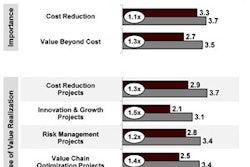
An executive briefing, "The Structure of Today's Supply Chain Organizations," based on the survey, notes that throughout the past five years, the organizational level of the senior-most supply chain executive has gradually moved higher.
Today, nearly half the retail and manufacturing companies surveyed have a supply chain leader at or above the executive vice president level. (Figure 1 below shows a breakdown by industry.)
"With supply chains becoming more dynamic and agile, organizations need to able to keep up with the pace," says Bruce Tompkins, executive director of the consortium and author of the briefing. "And these companies are beginning to realize the significance of having a high-level supply chain executive influence their business strategies."
Collaboration Still Developing
While supply chain leaders are moving up through the ranks and the title of "chief supply chain officer" is growing in use, there are still some areas within companies that lack collaboration between these executives and other areas of the organization. For example, the survey reveals that some companies do not have any part of their supply chain organization responsible for setting inventory targets.
Likewise, more than a quarter of retail companies and 14 percent of manufacturing companies surveyed have no formal process for aligning supply chain goals. Manufacturing companies tend to achieve goal alignment by reporting to a single executive, and retail companies generally have their common supply chain goals established by senior leadership.
"These gaps in goal alignment indicate significant opportunity for better communication and integration of supply chain functions," Tompkins adds. "However, companies are discovering these opportunities for improvement, and there is an increasing trend toward resource sharing across divisions and business units."
Elsewhere, the survey revealed that the functions reporting through the more senior supply chain executives are growing over time as more become consolidated under one organization and one leader. Transportation, distribution center operations, network design and planning functions are now commonly the responsibility of a senior executive (Figure 2 below.)
In addition, the outsourcing of supply chain functions is growing, particularly for execution functions such as distribution and transportation. Planning, provider selection and customer-facing functions tend to remain with internal resources.
The report is available (registration required) here.




















